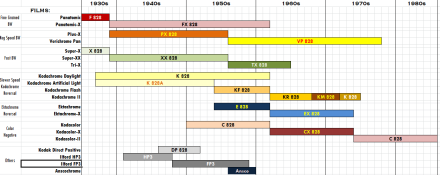Meyer Trioplan
Member
Good Day All,
I'm in the process of doing a collaboration for an eventual blog post that will elaborate upon the history of the 828 film format that was introduced in 1935 and discontinued in 1985. While this format was never significantly mainstream in the way that 135 and 120 were, and it didn't have quite the wide adoption that other formats like 116 and 127 did, it still strikes me as a fascinating format with some often impressive aspects.
As I dig through what I can and locate more information, I have found a lot of interesting tidbits about the format. For example, 828 is often thought of as a Kodak proprietary format. While Kodak is often credited (or reviled) for its creation, I am able to find numerous examples of 828 cameras that were not made by Kodak, most of which are basic, but at least a few of which are rather capable. As well, film for 828 was made by both Ilford and Ansco in its prime.
One misconception that I had when starting this was that 828 film offerings were simply derivative of 135 offerings since the film stock width is the same. Interestingly, that was hardly the case, at least for Kodak, as I can find at least 3 examples of 828 films that were not offered in 135 at certain points in their history. For example, Kodacolor 828 was released in September of 1950, nearly a decade before this color negative film was offered in 135.
Attached is a screen shot of a film timeline chart that I am working on for this project. This has been compiled from referencing old advertisements as well as expiration dates of films in my collection as well as those offered for sale. I would gladly take input on this based upon whatever evidence you might have regarding film availability at specific points.
Some of my hazy spots include:
Was Kodak Super Sensitive (SS) ever offered in 828?
I know DP was offered in 828 for a time in the late 40's, but was Kodak Microfilm or Infrared ever offered in 828?
Kodachrome-II codes seem to jump all over the place between K, KR, and KM starting in 1962. Is there any defined timeline of this?
When were Verichrome Pan, Kodachrome-II, and Ektachrome-X discontinued in 828? All I have to go upon is sale listings and internet image searches that I can compile a latest known expiration date.
When did Ilford make 828 film? All I have is a couple of internet images to give me a starting point, but there is little in the way of information otherwise.
Thanks, and enjoy!!!
I'm in the process of doing a collaboration for an eventual blog post that will elaborate upon the history of the 828 film format that was introduced in 1935 and discontinued in 1985. While this format was never significantly mainstream in the way that 135 and 120 were, and it didn't have quite the wide adoption that other formats like 116 and 127 did, it still strikes me as a fascinating format with some often impressive aspects.
As I dig through what I can and locate more information, I have found a lot of interesting tidbits about the format. For example, 828 is often thought of as a Kodak proprietary format. While Kodak is often credited (or reviled) for its creation, I am able to find numerous examples of 828 cameras that were not made by Kodak, most of which are basic, but at least a few of which are rather capable. As well, film for 828 was made by both Ilford and Ansco in its prime.
One misconception that I had when starting this was that 828 film offerings were simply derivative of 135 offerings since the film stock width is the same. Interestingly, that was hardly the case, at least for Kodak, as I can find at least 3 examples of 828 films that were not offered in 135 at certain points in their history. For example, Kodacolor 828 was released in September of 1950, nearly a decade before this color negative film was offered in 135.
Attached is a screen shot of a film timeline chart that I am working on for this project. This has been compiled from referencing old advertisements as well as expiration dates of films in my collection as well as those offered for sale. I would gladly take input on this based upon whatever evidence you might have regarding film availability at specific points.
Some of my hazy spots include:
Was Kodak Super Sensitive (SS) ever offered in 828?
I know DP was offered in 828 for a time in the late 40's, but was Kodak Microfilm or Infrared ever offered in 828?
Kodachrome-II codes seem to jump all over the place between K, KR, and KM starting in 1962. Is there any defined timeline of this?
When were Verichrome Pan, Kodachrome-II, and Ektachrome-X discontinued in 828? All I have to go upon is sale listings and internet image searches that I can compile a latest known expiration date.
When did Ilford make 828 film? All I have is a couple of internet images to give me a starting point, but there is little in the way of information otherwise.
Thanks, and enjoy!!!
Attachments
Last edited by a moderator:











 ....used bog-standard 828 film inside sealed plastic proprietary film cartridges that could 'only be processed by mailing in to Traid's photo lab'.
....used bog-standard 828 film inside sealed plastic proprietary film cartridges that could 'only be processed by mailing in to Traid's photo lab'.